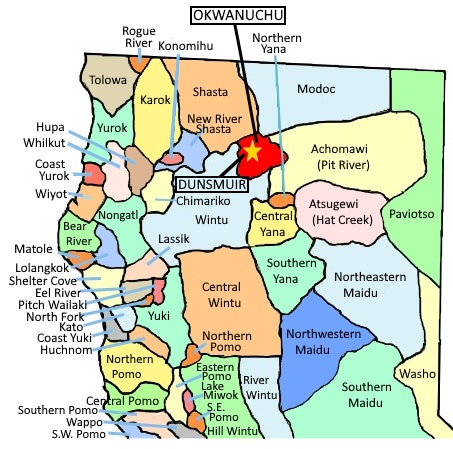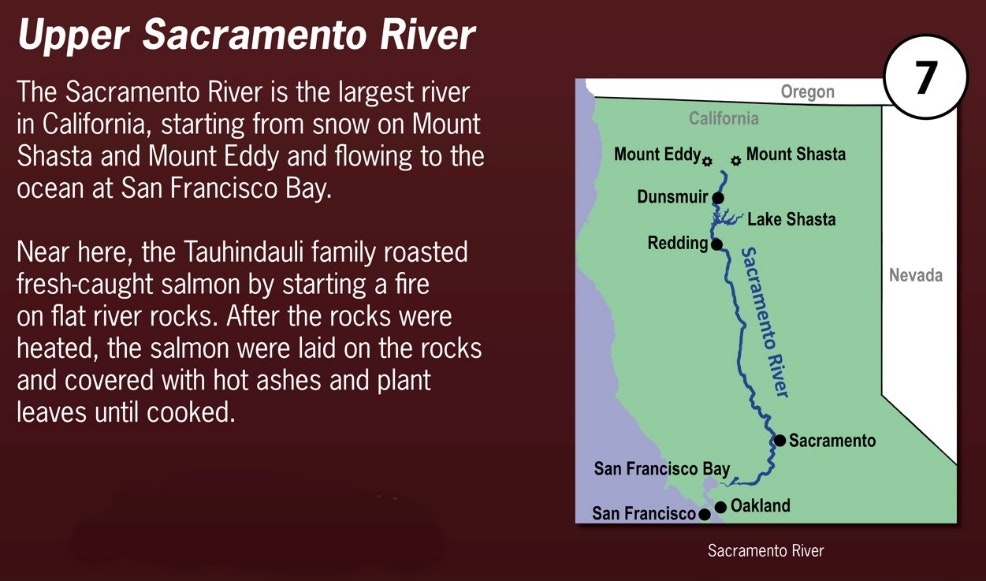Self-Guided Tour Sign #6 - Native Americans

At the time of the California Gold Rush, the inhabitants of the area around Dunsmuir were members of the Okwanuchu tribe; their range included north of Mount Shasta City, the southern slopes of Mount Shasta, east past the town of McCloud, and south along the Sacramento and McCloud rivers to near today’s Lake Shasta. Little is known about these people other than that they were hunter-gatherers who likely followed traditional patterns—hunting deer and other game, gathering local edible plants such as acorns and roots, and coming to the Sacramento and McCloud rivers to fish, especially during salmon runs. They followed the seasons—moving to lower elevations during colder months, and moving to higher elevations during warmer months. Probably never more than several hundred people in total, by the 1870’s when information began to be gathered about native peoples, the Okwanuchu had long since retreated into the deeper forests and sadly had died out years earlier.
For more detailed information, continue reading below.
Anthropologists and scientists debate exactly when and how the first humans came to the Americas and when and how they first reached the interior of California. One view is that about 25,000-30,000 years ago, hunter-gatherers living in today’s northeastern Siberia (now part of Russia) wandered from Siberia to the interior of Alaska following wild game. Then about 25,000 years ago, these early people found the empty Alaskan coastlands rich in food and other resources, and began to expand east and south along the Alaskan coast, increasing their numbers.
Small groups of families would break off from the main group and begin to look for new land for themselves and their children. These break-away families, using boats, began to migrate down the West Coast of North America. Again these early humans found the unpopulated coast farther south full of food and other resources.
The same pattern repeated itself hundreds of times over the next several thousand years—a small group of hunter-gatherer families would leave an established area, and find a new unpopulated area where they could spend the seasons, going into higher elevations in the summer and into lower elevations and farther south in the winter. Some of these groups continued to follow the Pacific coastline south, while others of these groups followed rivers deeper into the interior of North America and spread out from there.
These First Peoples had the benefit of hunting mammoths, mastodons, giant tapirs, giant sloths, and other large animals which had no natural fear of humans. The protein, hides, and other resources from these megafauna provided reliable sustenance as humans continued to expand throughout North and South America. The earliest record of humans in North America is at White Sands, New Mexico, and dates to approximately 23,000 years ago.
By comparison, up until about 9,000-10,000 years ago, the climate around Dunsmuir was very cold and snowy, and there were still a lot of glaciers around here—for example, glaciers extended far down the slopes of Mount Shasta, and extended east and north from today’s Castle Lake. As the climate warmed and the glaciers began to retreat, the area around Dunsmuir became more suitable for human habitation. It was around this time that perhaps a group of hunter-gatherers followed today’s Rogue River up from the coast, finding an unpopulated land with available food and other resources, and from there, their descendants began to expand into the interior of today’s southern Oregon and into Siskiyou County.
By about 8,000 years ago, however, humans had expanded into almost all the unpopulated areas of California and the Pacific Northwest, and the mammoths and other megafauna had become scarce or extinct. Since there were now people living in all the best places, expanding groups of families could no longer simply travel to an unpopulated area and establish themselves as the first people there. Instead, competition began to increase as groups formed themselves into tribes united by language, history, and customs. This competition for increasingly over-crowded land and resources grew sharper and became a matter of life and death. Inter-tribal raids, slavery, and open warfare became ordinary features among many of the tribes.
A new pattern then began to develop. One tribe would find a slightly better way to, for example, catch fish or to store food, and that tribe would expand in population. The only way for that tribe to continue to expand would be to take over the land of their neighbors. Sometimes this was accomplished peacefully by intermarrying with the neighboring tribe; other times it took physical violence to force the neighbor tribe to move or be killed. Still other times, hardship such as drought or famine would force a group of people to move to a different area—again, pushing out or intermarrying with the people who had been living in that area perhaps for a thousand years. For example, in the 1870’s it was recorded that old stories told by the Shastan tribe included that when they first arrived in the lands north of Mount Shasta, there was another tribe already present. Warfare followed, and the Shastan successfully forced the original inhabitants to move farther south.
Anthropologists believe that some three to five different groups of people lived in and around Dunsmuir and the Sacramento River Canyon during the most recent 8,000 years. Each group would go where that season’s fish, game, roots, acorns, and berries were best that year. They would follow this circuit for perhaps a thousand years, until a stronger group of people would appear. This new, stronger group then intermarried or forced out or killed the existing group, and the new group took over their range. This pattern would be repeated a thousand or two thousand years later when a third group would enter and take over the land.
The losing groups in this process migrated to land where food and other resources were more scarce, and they made do as best they could, They kept their traditions, language, and customs alive—but this time, living on poorer land that the stronger tribe was not interested in.
In still other situations, a small group would decide to separate themselves, to find land no one else wanted and establish themselves there. Like some groups today (for example, the Amish), these small groups could want to be separated or secluded so they could follow special religious practices, or perhaps simply follow a more traditional life and customs. These small groups found ways to hide their presence and if stronger tribes came raiding for slaves or food, these small groups knew ways to hide in the forests and hills until danger had passed.

After thousands of years of multiple turns of this cycle—existing groups being pushed farther and farther into poorer lands—the landscape of Siskiyou County and Northern California was covered with a dazzling mosaic of dozens of different tribes, languages, religions, histories, and customs.

The Okwanuchu and other Indigenous people in Northern California lived a life very similar to how other hunter-gatherer groups of early humans lived during the last 100,000 years. For example, their primary tools were made of wood, bone, or stone, and food was usually cooked on open fires or using a “hot rock method” of cooking. Food was then stored in woven baskets. They made no use of pottery, metal, the wheel, writing, or beasts of burden. Life centered around the ability to move multiple times a year. Families lived in small temporary shelters made of branches and reeds that could be easily re-built in each different temporary location each year. Women were expected to gather and prepare food in addition to caring for children and the elderly. Men hunted and provided protection against attacks from neighboring tribes.


